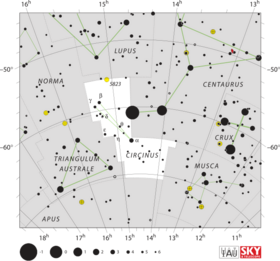Astronomy:Gamma Circini
| Observation data Equinox J2000.0]] (ICRS) | |
|---|---|
| Constellation | Circinus |
| Right ascension | 15h 23m 22.64294s[1] |
| Declination | −59° 19′ 14.8131″[1] |
| Apparent magnitude (V) | 4.51[2] (4.94 + 5.73)[3] |
| Characteristics | |
| Spectral type | B5 IV[4] + F8 V[2] |
| Variable type | Be[5] |
| Astrometry | |
| Radial velocity (Rv) | 16.90±1.78[6] km/s |
| Proper motion (μ) | RA: −12.97[1] mas/yr Dec.: −34.24[1] mas/yr |
| Parallax (π) | 7.27 ± 0.81[1] mas |
| Distance | approx. 450 ly (approx. 140 pc) |
| Absolute magnitude (MV) | −1.18[7] |
| Orbit[4] | |
| Period (P) | 258 yr |
| Semi-major axis (a) | 2.576″ |
| Eccentricity (e) | 0.931 |
| Details | |
| γ Cir A | |
| Mass | 6.0±0.3[8] M☉ |
| Temperature | 15,135[9] K |
| Age | 63.1±19.6[8] Myr |
| γ Cir B | |
| Temperature | 4,786[9] K |
| Other designations | |
| γ Cir A: HD 136415 | |
| γ Cir B: HD 136416 | |
| Database references | |
| SIMBAD | γ Cir AB |
| γ Cir A | |
| γ Cir B | |
Gamma Circini, Latinized from γ Circini, is a star system in the constellation Circinus. It was noted as a double star by Herschel in 1835, who estimated the separation as 1 arc second.[11] It is visible to the naked eye with an apparent visual magnitude of 4.51.[2] Based upon an annual parallax shift of 7.27 mas,[1] it is about 450 light-years away.
This is a wide binary star system and may even be a triple star.[9] The two visible components orbit each other with a preliminary estimated period of 258 years and a large eccentricity of 0.931.[4] As of 2014, the visible components have an angular separation of 0.80 arc seconds on a position angle of 359°.[3]
The primary star, component A, is a B-type subgiant star with a stellar classification of B5 IV.[4] Based upon isochrone curve fitting it is hypothesized to be a pair of matching B5 stars,[9] and is a Be variable with an uncertain maximum.[5] It has an effective temperature of 15,135[9] K and an estimated mass six[8] times that of the Sun. The companion, component B, is an F-type main-sequence star with a stellar classification of F8 V.[2] It has an effective temperature of 4,786[9] K.
References
- ↑ 1.0 1.1 1.2 1.3 1.4 1.5 van Leeuwen, F. (2007), "Validation of the new Hipparcos reduction", Astronomy and Astrophysics 474 (2): 653–664, doi:10.1051/0004-6361:20078357, Bibcode: 2007A&A...474..653V.
- ↑ 2.0 2.1 2.2 2.3 Buscombe, W.; Barkstrom, B. (1971), "The composite spectrum of gamma Circini", Monthly Notices of the Royal Astronomical Society 152: 37–45, doi:10.1093/mnras/152.1.37, Bibcode: 1971MNRAS.152...37B.
- ↑ 3.0 3.1 Mason, B. D. et al. (2014), "The Washington Visual Double Star Catalog", The Astronomical Journal 122 (6): 3466–3471, doi:10.1086/323920, Bibcode: 2001AJ....122.3466M, http://vizier.u-strasbg.fr/viz-bin/VizieR?-source=B/wds, retrieved 2015-07-22
- ↑ 4.0 4.1 4.2 4.3 Malkov, O. Yu. et al. (2012), "Dynamical masses of a selected sample of orbital binaries", Astronomy & Astrophysics 546: A69, doi:10.1051/0004-6361/201219774, Bibcode: 2012A&A...546A..69M.
- ↑ 5.0 5.1 Kazarovets, E. V. et al. (1999). "The 74th Special Name-list of Variable Stars". Information Bulletin on Variable Stars 4659: 1. Bibcode: 1999IBVS.4659....1K.
- ↑ de Bruijne, J. H. J.; Eilers, A.-C. (October 2012), "Radial velocities for the HIPPARCOS-Gaia Hundred-Thousand-Proper-Motion project", Astronomy & Astrophysics 546: 14, doi:10.1051/0004-6361/201219219, A61, Bibcode: 2012A&A...546A..61D.
- ↑ Anderson, E.; Francis, Ch. (2012), "XHIP: An extended hipparcos compilation", Astronomy Letters 38 (5): 331, doi:10.1134/S1063773712050015, Bibcode: 2012AstL...38..331A.
- ↑ 8.0 8.1 8.2 Tetzlaff, N. et al. (January 2011), "A catalogue of young runaway Hipparcos stars within 3 kpc from the Sun", Monthly Notices of the Royal Astronomical Society 410 (1): 190–200, doi:10.1111/j.1365-2966.2010.17434.x, Bibcode: 2011MNRAS.410..190T.
- ↑ 9.0 9.1 9.2 9.3 9.4 9.5 Parsons, Sidney B. (May 2004), "New and Confirmed Triple Systems with Luminous Cool Primaries and Hot Companions", The Astronomical Journal 127 (5): 2915–2930, doi:10.1086/383546, Bibcode: 2004AJ....127.2915P.
- ↑ "* gam Cir". SIMBAD. Centre de données astronomiques de Strasbourg. http://simbad.u-strasbg.fr/simbad/sim-basic?Ident=%2A+gam+Cir.
- ↑ Carette, E. et al. (April 1995), "γ Circinus: a young visual binary with pre-main-sequence component(s)?", Astronomy and Astrophysics 296: 139, Bibcode: 1995A&A...296..139C.
- ↑ "MAST: Barbara A. Mikulski Archive for Space Telescopes". Space Telescope Science Institute. https://mast.stsci.edu/portal/Mashup/Clients/Mast/Portal.html.
External links
 |



